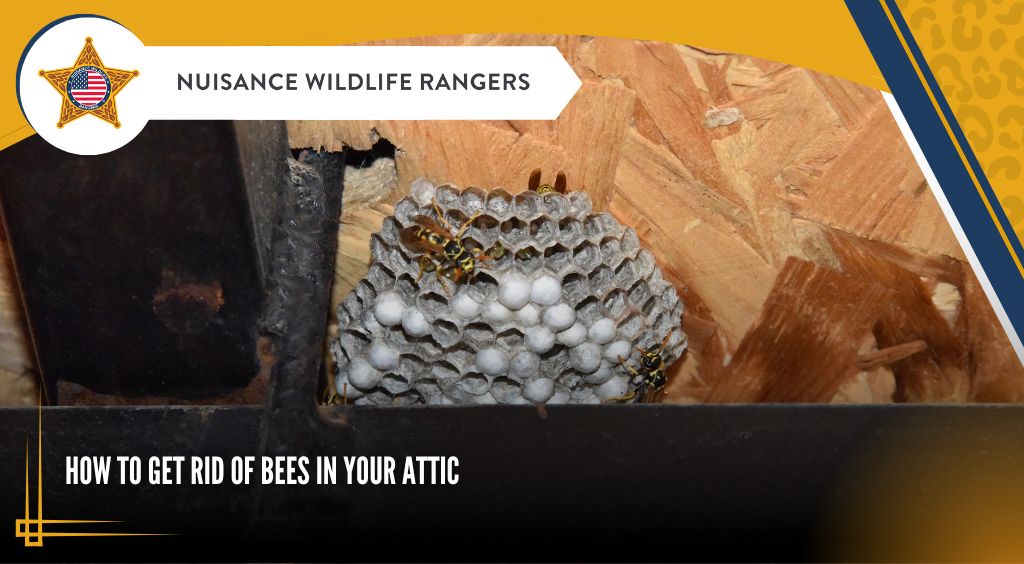 Bees are extremely important to our ecosystem and livelihood. According to a study, 70 out of the top 100 human food crops are pollinated by bees. This means 90% of the world’s nutrition relies on them.
Bees are extremely important to our ecosystem and livelihood. According to a study, 70 out of the top 100 human food crops are pollinated by bees. This means 90% of the world’s nutrition relies on them.
Bees are important to the planet, so people take necessary steps to protect them. While bees are vital to the ecosystem, you never want them living in your home. Oftentimes, bees take shelter in people’s attics because it is safe from the elements.
Even though people need to protect bees, that does not mean they have to allow them to live in their attics. Many people are allergic to bees and having them in the home increases the risk of getting a bee sting.
Thankfully, there are humane and ethical ways to remove bees from your attic. Professional companies like Nuisance Wildlife Rangers can trap and relocate bees that have made your attic their home.
What Types of Bees Live in Attics?
When most people imagine bees, they picture honeybees. While honeybees are common, there are an estimated 20,000 different bee species out there. Honeybees usually do not live in attics, however, other types of bees like bumblebees and carpenter bees might.
Bumblebees are more solitary, which makes an attic a perfect place for them to live. Additionally, carpenter bees get their name from their ability to drill holes into wood to create nests. Carpenter bees are skilled at getting into attics.
Why Do Bees Like Attics?
Before a bee begins nesting, it will look for a place to keep its colony safe from the elements and several predators. Usually, they look for deep and dark spaces to call home, making your attic the perfect location.
Bees like attics because they provide protection and the wood is easy to build honeycombs on. Once bees enter your home, they only need three days to build up to ten hive frames. This means a bee infestation could get large pretty quickly.
When someone finds bees in their attics, they might find up to 150 pounds of honeycombs. Since bee infestations get out of hand quickly, it is best to contact a professional for help.
Signs of a Bee Infestation in Your Attic
Three main signs indicate you have a bee infestation in your attic. These signs include unusual bee activity, spotting an active bee nest, and dark patches on your walls or ceilings. Having a full understanding of the signs of a bee infestation in your attic can help you determine whether it’s time to call a professional pest controller.
The signs that bees are occupying your attic include:
- Unusual Bee Activity – if you spot bees in unusual places around your home, they are likely living in your attic. You might notice them flying around in your kitchen, on your porch, or above your roof outside.
- Active Nests – if you spot a nest inside of your home, in your attic, or on your lawn, you could have a bee infestation. Bee nests can extend past walls, doors, and even floorboards.
- Dark Spots – if you notice new dark spots on your walls or ceilings, it could be from a beehive in your attic. This is because some of the honey will begin seeping out of the hive, causing discoloration on surfaces.
How to Remove Bees From Your Attic
It is best to remove animals and relocate them when they are infesting your home. This is especially true for bees, as they are important to the ecosystem. However, bee infestations in your attic can cause thousands of bees to swarm, making removing and relocating bees a complicated process. This is why you should always contact a professional like Nuisance Wildlife Rangers.
When we are removing bees from your attic, we will use one of the following tactics:
- Catch the Queen bee and relocate her to a temporary hive. This causes the other bees to follow.
- Use a carpenter bee trap when the infestation is in the early stages.
- Secure the entry points to the attic and smoke the bees out with a beekeeping smoker that will not harm them.
Once the bees are removed, you should take steps to prevent them from returning. The steps you can take include:
- Closing any construction gaps that allowed them to enter
- Keep blue, purple, and yellow flowers that attract bees away from the home
- Cover spots that allow bees to invade, like grills or sheds
- Remove dormant hives from your property
- Use natural repellants like peppermint plants, cucumber peels, and cinnamon
Get Connected to a Professional Bee Removal Company
If you have a bee problem in your attic, Nuisance Wildlife Rangers are here to help. We can relocate and remove bees to keep them and your family safe at the same time.
Contact us today to learn more about how we can help you get rid of bees in your attic.
